|
To get in the right mood for this interview, you might actually want
to read the original TV-Guide article - Aug 27 through Sep 2, 1960
- about the then new Popeye-show first - so click here to do just that!
In 1960, Popeye the Sailor, by then a very popular character
from comicstrips, comicbooks and especially theatrical cartoons, made his
debut in a series of made-for-television cartoons. So how did his
transition to TV cartoon character come about?
I think it best to let Al Brodax, the executive
producer, explain how the series came about - quoted from the publication Beatletoons
(Wynn Publishing 1999): “At the time Popeye was running very high in the
ratings. These were the old Max Fleischer Popeyes that were distributed by
Paramount. I thought it would
be a good business move to announce that we’re making 220 new Popeyes in
color and that they were up for grabs.
The investment was a mere twenty five thousand dollars for two five
and a half minute pieces (the two pilot cartoons: Barbecue
for Two and Hits and Missiles).
It (the entire series) grossed three million dollars in our first
year simply by going to the stations who already had big success with the
old Popeyes. What I did was I
recorded all of the soundtracks in New York to create a uniform sound, and
I had a kid waiting downstairs to send the tracks to places like
Czechoslovakia, Los Angeles and some went to Australia.
But I had six studios going at once to get them all done.
Multiple studios were used when you have a limited amount of time
on your hands.”
These cartoons were a huge financial success for King
Features Syndicate. According
to an article in the October 25, 1961 edition of Variety:
“King
Features Syndicate’ sales of the new made- for-TV Popeye
cartoons has just passed the $4,500,000 mark. King has so far delivered
150 of the new Popeyes. Production of the remaining 70 is due to be
completed early next spring. Animation
is being done in both Hollywood and New York.”

The June 10, 1964 edition of Variety carried the headline, “Popeye’s $20,000,000 Gross”
which detailed the success both the theatrical and made-for-TV cartoons
were having on television. At the time of the article 190 U.S. stations
aired the theatrical films with King’s Popeye sold to about 125
stations. The success of the new Popeye series increased the amount of
licensed merchandise. The
items were so great in number King
Features Syndicate published a Popeye
merchandise catalog in 1962. Before we
dig any deeper into the Popeye story: While animated TV shows are a
dime a dozen nowadays, what can you tell us about the state of TV
animation around the time the Popeye-series was launched?
When
these television cartoons were launched audiences were still getting
accustomed to viewing animated series aired in early evening time periods.
This was the case with
Huckleberry Hound, Yogi
Bear, Rocky and his Friends and Mr.
Magoo. While animated
films were still being produced theatrically, the field was shifting to
accommodate television. Veteran animators had to get accustomed to the
limited animation technique which required fewer drawings.
As
far as I know, King
Features Syndicate set out to release no less than 220 cartoons
between 1960 and 1962 - as compared to the 234 theatrical cartoons that
were previously produced over a (roughly) 25 year timeframe. Why that
volume in such a short time? King
Features Syndicate wanted to come close to the number of Popeye films
which were released theatrically. Many
TV-cartoon series, at this time, produced at least 100 episodes but having
220 certainly made the series more attractive for television stations to
purchase. No one studio can produce
220 shorts in 2 years (or at least could then), so King
Features Syndicate hired a total of no less than five studios -
could you talk about each of those and their rendition of Popeye
for a bit?
The artistic renditions of J. Wellington
Wimpy, Swee’pea and The Sea Hag remained consistent with slight
variations depending upon the studio and animators involved. However
Popeye, Olive Oyl and Brutus were another matter. Popeye,
for example, would have a medium or overly large sized chin.
Both of the sailor’s eyes remained open or one would close.
Brutus’ beard would look mangier in some episodes than others.
Olive’s facial design would alternate in different cartoons.
These changes were reflected by the artists’ styles.
The attire for the main cast, with the exception of one of the
pilot cartoons, remained consistent. What can you tell us about the animation of
the series (maybe studio by studio), and how well does it hold up to the
theatrical cartoons?
No studios matched the quality of the
theatrical cartoons simply because of the limited time and financing
provided. Here is a brief
summary of the studios involved with the production of the television
cartoons:
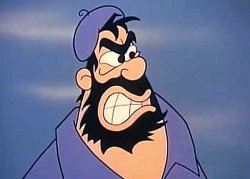
Matinee Idol Popeye |
 |
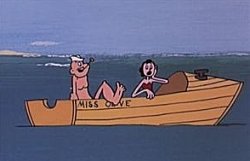
Sea No Evil |
Gene Deitch and
William L. Snyder - William L. Snyder was one of the first Americans to do
business in post Eastern Europe. He
imported European films though his production company, Rembrandt Films,
founded in 1949. In 1959 he
began an association with Gene Deitch, the former head of UPA
Studios, to
produce animated cartoons in Prague. These
cartoons included Tom and Jerry for MGM and
Popeye for King
Features Syndicate. Their 28 Popeyes credit Snyder as
producer and Deitch as supervising producer.
The animation quality improved greatly when the names John Halas
and Joy Batchelor appeared in the opening credits. The films The Billionaire, Model Muddle,
Matinee Idol Popeye, Weight
for Me, and Which is Witch all benefited from this team’s efforts.
Deitch and Snyder’s other efforts do not feature horrible
animation but, on occasion, the character designs are overly simplified as
seen in Hag Way Robbery,
Partial Post, Swee’pea Soup
and Sea No Evil. Enjoyable
cartoons include: The Lost City
of Bubble-On, From Way-Out, Roger, Canine
Caprice, Goon With the Wind and There’s
No Space Like Home (where,
in a rare turn of events, Brutus feeds spinach to Popeye to stop an alien
invasion). These films are best remembered for their eerie musical scores.
|
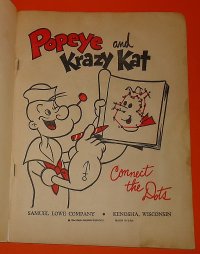
|
Gene Deitch, who later produced TV-cartoons, based on the Krazy Kat comic strip, recalled, “I made the biggest pitch I could
to him (Al Brodax) to let me take Popeye and Krazy Kat back to their Segar
and Herriman (George Herriman, the creator of Krazy Kat) roots.
But I had only superficial success.
It was argued that by that time, the early 1960s, most people knew
Popeye from the movie cartoons, and not the E.C. Segar comic strip Popeye
of the 1930s. And because of
the number of episodes needed, we would have to divide the animation
between Prague, Zagreb and Rome. The
stories were all organized by Brodax in New York. I could control only the
layouts and the soundtracks, for all of the films; I had to ricochet from
city to city in the effort to control visual unity.”
Brodax said the foreign-made Popeyes cost less than $14,000 each,
compared with the $15,000 cost of similar Popeye cartoons made recently in
the U.S. He added the
foreign-made Popeyes contain “substantially more animation” than the
American-made cartoons.
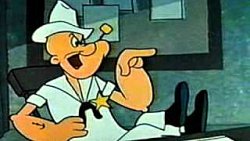
Dead-Eye Popeye |
Larry Harmon -
According to a 1966 TV Guide article Harmon was a movie actor, TV
producer, director, scriptwriter, composer, musician, talent agent, voice
specialist and puppeteer. In
1956 he secured the television rights to Capitol Records’ Bozo
the Clown character. Harmon
put together an animation studio to produce 156 Bozo-cartoons.
His studio was contracted to produce 18 Popeyes for King
Features Syndicate in addition to working on UPA’s Mr.
Magoo and Dick Tracy films. The
director for his Popeyes was Paul Fennell and the artists involved were
Tom Baron, C.L. Hartman, Z.T. Jablecki, Lou Schemer, Ervin Kaplan, George
Rowley, Jean Blanchard, Hal Sutherland, Cal Dalton and Frank Onaitis.
Scripts were credited to Charles Shows with editing by Dan Milner and
music by Gordon Zahler. While
many of the stories are entertaining, the simplified character designs can
be distracting. There would be
scenes when Brutus’ short sleeved shirt would suddenly become long
sleeve, then back to short. Often,
when the characters spoke, heads would bob back and forth in rapid motion.
Enjoyable films include Ace
of Space, Dead-Eye Popeye, Caveman
Capers, Foola-Foola Bird, Uranium on
the Cranium, Track Meet Cheat
and Crystal Ball Brawl.
|
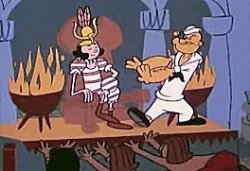
Egypt Us |
Gerald Ray worked
with Walt Disney and later Jay Ward, who is best known for his work with Rocky,
Bullwinkle, Dudley Do-Right
and George of the Jungle.
Ray formed a commercial animation studio in New Mexico where he
lived for many years. Ray is
best known for his successful King Leonardo and His Short Subjects series.
While the character designs in Ray’s Popeye cartoons do not have
a polished look, they are suited for the storylines.
The scripts are very clever and the personnel involved certainly
had a fondness for the characters. All 10 of Ray’s Popeye cartoons have
enjoyable moments. In Where
There’s a Will, Brutus tosses a spinach can in Popeye’s direction.
Upon hearing the familiar spinach-eating theme he looks at the
audience and says “Whoops, I shouldn’t have done that!”
Take it Easel had Popeye and Brutus competing in a frantic painting
contest. Egypt Us has Wimpy, rather than Popeye, singing the cartoon’s
closing song; “It’s bad to be tardy to a hamburger party says Wimpy
the Burger Man”. Each of
Ray’s cartoons ended with a cute song.
The director of these films was Bob Bemiller with layout by Henry
Lee. Backgrounds were provided
by Dave Weidman and the editor was Norm Vizents.
Animators were Izzy Ellis, Sam Kai, Casey Onaitus, Ray Young, Bill
Higgins, Barney Posner, John Garling and Bud Partch.
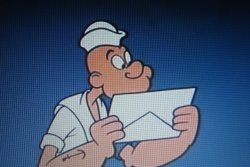
Mississippi Sissy |
 |
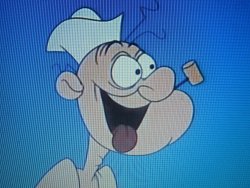
Golden Type Fleece |
Jack Kinney - Kinney was given the bulk of the Popeye cartoons to produce with a
101 entries. Al Brodax told me
Kinney was given this task as he “was a respected Disney animator”.
Kinney was a director on the popular Goofy animated theatrical series.
Leaving Disney in 1959 he formed his own studio working on Dick
Tracy, Mr. Magoo and The Alvin Show.
Kinney had several animation directors and these individuals played
a major factor in the quality of the animation.
Whenever the name Hugh Fraser appeared as the animation director,
you were probably watching a poorly animated cartoon. Episodes to avoid
include Popeye the Popular Mechanic,
Rip Van Popeye, Time
Marches Backwards, Old Salt
Tale, Invisible Popeye, Popeye and
the Giant, Mississippi Sissy, Double
Cross Country Feet Race, Time
Marches Backwards and Popeye’s
Tea Party. Watchable
entries under Fraser’s direction include The
Day Silky Went Blozo, Popeye’s Used Car, Popeyed
Columbus, Aztec Wreck, Popeye
in Haweye and Popeye’s Fixit
Shop. Animation director
Eddie Rehberg’s output ranges from the mediocre Popeye’s
Pizza Palace, Frozen Feuds,
After the Ball Went Over, Forever Ambergris to the tolerable Popeye’s
Museum Piece, The Glad
Gladiator, Popeye and The
Herring Snatcher, and Lighthouse
Keeping. Kinney’s
cartoons under the guidance of animation directors Volus Jones, Ed
Friedman, Rudy Larriva, Harvey Toombs, Ken Hultgren and Alan Zaslove had
their occasional awkward animated moments but were generally well done. Enjoyable
episodes by these men include Popeye
in the Grand Steeple Chase, Popeye the Lifeguard, Bell Hop Popeye
(Harvey Toombs), Popeye’s Pep-Up Emporium, Olive Drab and The Seven
Sweapeas, Popeye’s Hypnotic Glance
(Ed Friedman & Volus Jones), Golden
Type Fleece, Popeye Revere,
Popeye and the Phantom (Ken Hultgren), Bottom Gun, Popeye’s Pet
Store, The Square Egg (Rudy Larriva) and Spinach Shortage (Alan Zaslove).
|
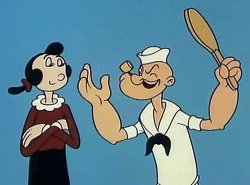
After the Ball Went Over |
 |
|
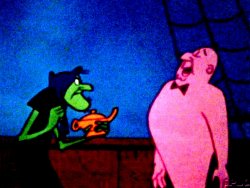
Aladdin's Lamp |
Kinney’s
scripts are often very funny with a wink to the audience.
For example in After the
Ball Went Over Popeye is
playing ping pong with Brutus. The winner of the match receives a kiss
from Olive Oyl. Popeye says to Olive, “Fat Boy doesn’t have a chance.
If I gets in trouble I can always use me spinach gimmick” and
“Ya know I always wins in these stories” - but the sailor ends up losing
when a trick intended for Brutus backfires.
Olive asks a battered Popeye is there anything special he wants.
The sailor looks at the audience and says, “Yeah a new writer to puts me
spinach back in the script!”
Paramount Cartoon Studios - The studio was
previously known as Famous Studios and produced Popeye’s theatrical
films. Their 63 TV Popeyes
looked polished considering the restrictions of limited animation
techniques. The films also benefited from Winston Sharples durable musical
scores (heard in the Popeye theatrical adventures).
Seymour Kneitel was the director and contributed to the stories.
Other writers were Carl Meyer and the voice of Popeye, Jack Mercer.
Scenics were provided by Anton Loeb and Robert Owen.
Animators included WM B Pattengill, I. Klein, Jim Logan, George
Germanetti, Morey Reden, Dante Barbetta, John Gentilella, Dick Hall, Gerry
Dvorak, Jack Ehret, Irving Dressler, Nick Tafuri, Sam Stimson and Al
Pross. Enjoyable episodes
include Strikes, Spares an Spinach,
Rags to Riches to Rags, Aladdin’s
Lamp, My Fair Olive, Gem Jam
and A Poil for Olive Oyl.
Generally all of the TV Popeyes produced by Paramount are enjoyable to
watch.
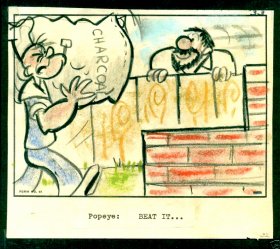
Barbecue for Two storyboard sketch |
Having cartoons based on the same
characters by five different studios, it's almost inevitable that the
style varies quite a bit. So which studio's rendition of the characters
comes the closest to E.C. Segar's, which to the Fleischer and Famous
cartoons? There
is only one cartoon which came close to matching Segar and Fleischer’s
version of the characters. Barbecue for Two was one of two pilot
cartoons produced to help sell
the series to television stations. The
cartoon was produced by Jack Kinney and featured the comic strip designs
of both Popeye and Olive Oyl. Popeye
wore his traditional black shirt, red collar with black stripes and
captain’s hat while Olive retained her traditional homely appearance.
The film was written by Dick Kinney and Al Bertino.
Layout for the cartoon was by Bruce Bushman with animation by
Harvey Toombs, Eric Cleworth, Abe Levitow, Volus Jones and Bill Keil.
For the rest of the series Popeye wore his white sailor’s
uniform. While Olive wore her
attire from the comic strip she kept the prettier facial design from the
majority of the Famous Studios cartoons.
Her hair was fuller with pretty eye lashes.
It should be note the bearded “brute” in this film does not
have a name and is referred to as “neighbor” and “Junior”.
This may have been produced before Bluto was rechristened Brutus by
Al Brodax. Which studio's rendition of Popeye do you
prefer in terms of stories, in terms of gags, in terms of design and in
terms of animation? Overall I prefer the cartoons produced
by Paramount Cartoon Studios because they looked like an extension
of the Famous Studios series. This was, of course, due to the same
personnel working on both the theatricals and television films. I do not
want to give the impression I avoid watching the work of the other
studios. Each produced enjoyable episodes but overall I prefer the
cartoons under the direction of Seymour Kneitel.
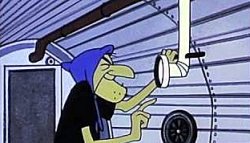
The Sea Hag in
Olive Drab and The Seven
Sweapeas |
 |
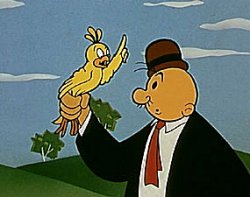
The Whiffle Bird's Revenge |
While the theatrical cartoons
focused mainly on Popeye and Bluto fighting over Olive Oyl, the
TV-cartoons brought back a host of other characters from the Popeye-comics.
Why don't you talk about these "new additions" for a bit, and
their small-screen renditions? King
Features Syndicate controlled the rights to the characters in the Popeye
comic strip. Therefore these
figures could be incorporated into the plots of the television cartoons.
The Sea Hag, who debuted in the Thimble
Theatre comic strip in 1929, made her animation debut here.
She was a welcomed sight, giving Popeye someone, other than Brutus,
to spar with. Also Olive Oyl
became a stronger character due to the witches’ presence.
Popeye could not hit the old hag due to his sailor’s code.
Consequently it was Popeye’s beanpole girlfriend who ate the
spinach and bopped The Sea Hag. Wimpy
was able to mooch hamburgers from the same chef who hated him in the comic
strip: Rough House. Eugene the
Magical Jeep appeared in several fantasy based plots.
Alice the Goon, who gave children nightmares when she originally
appeared in the comic strip, showed up with a big crush on Popeye.
Swee’pea, who was either in Olive or Popeye’s care depending
upon the storyline, was a main character in several episodes.
King Blozo, who was a worrisome ruler, appeared in a handful of the
cartoons and originated from the funny pages. The Whiffle Bird, whose
magic gave Popeye his initial strength in the comic strip, appeared in a
few cartoons. Because of these characters the storylines were not limited
to the Popeye-Olive-Brutus romance triangle.
|
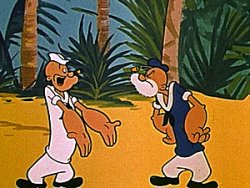
Me Quest for Poopdeck
Pappy |
 |
|
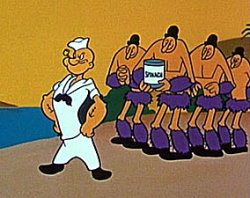
The Valley of the Goons |
I've read that the TV
cartoons produced by Paramount
and directed by Seymour Kneitel occasionally incorporated original
storylines from E.C. Segar's Thimble Theatre strips - want to talk
about these for a bit, and how faithful did these films remain to Segar? It
is a difficult task to take a storyline which ran for months in the
newspapers and whittle it down to a five minute cartoon.
Seymour Kneitel and his crew did an excellent job of remaining
faithful to the source material. These
Segar-inspired cartoons were It
Only Hurts When They Laugh
(based on a Sunday strip where Olive tries to stop Popeye from brawling
but laugh instead), Poppa Popeye
(the Sunday strip had Swee’pea’s mother returning to claim the infant
but a phony father tries it in
the cartoon), Me Quest for Poopdeck
Pappy (which takes elements and dialogue from Popeye’s reunion with
his father right from the daily strip), What’s
News (Popeye takes over a newspaper as he did in a daily storyline), Wimpy
the Moocher (Wimpy uses a pearl in an oyster to outwit Rough House
based on a Sunday page), Myskery Melody (which
was an excellent pairing down of a lengthy daily story of the same
title) and The Valley of the Goons (a plot taken from one of Segar’s last
scripted tales involving the residents of Goon Island).
Who provided the voices for the principal Popeye
cast in the cartoons? Jack
Mercer, Mae Questel and Jackson Beck provided all of the voices for the
characters in the cartoons. Mercer
was Popeye and Wimpy while Questel was Olive Oyl, Swee’pea, The Sea Hag
and Deezil, Olive Oyl’s niece. The
trio would provide the voices for all of the secondary characters and, on
occasion, would alternate who did the voice.
In Sea No Evil Jack
Mercer was the voice of Brutus. Rough
House’s voice was provided by both Beck (Wimpy
the Moocher) and Mercer (The
Whiffle Bird’s Revenge).
Some of your TV-Popeye
favourites? And are there some you really dislike? Before
I discuss my favorites I want to give this a more personal spin.
I first discovered these TV cartoons on my local Popeye
and The 3 Stooges program around 1967-68.
It was a half-hour mix of the theatrical and King
Features episodes. As a child I did not
see any faults in the animation. To me it was just more of my favorite
cartoon character! As a teenager I recall when first watching Popeye
and The Giant,. I
immediately noticed the stock footage, from other Jack Kinney cartoons,
used in this episode. I was
aghast! I was even more
discouraged as the cartoon progressed. At the conclusion of the cartoon
the animators made Popeye’s mouth move as if he was talking.
Unfortunately the sailor had no dialogue so faint laughter was dubbed in.
I began to notice other animation goofs and began to really
appreciate the better entries in the series.
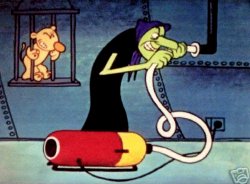
Hag Way Robbery |
In my opinion the worse
cartoons in the series list Hugh Fraser as animation director and I have
already mentioned these titles. Other
episodes low on my list are Larry Harmon’s Muskels Shmuskels, Hoppy
Jalopy and Ski Jump Chump.
The stories are fine but some of the animation sequences make me
cringe. Hag
Way Robbery, from Gene Deitch and William Snyder, may feature Eugene
the Jeep and The Sea Hag but the animation is much too simplistic in
spots. In one scene Olive Oyl is holding an armless Swee’pea! From
Gerald Ray I could never warm up to Popeye’s Junior Headache because Olive Oyl’s bratty niece beats
up her babysitter, Popeye.
|
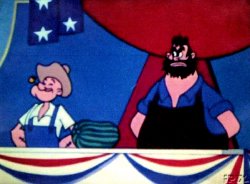
County Fair |
The
Baby Contest, which has Swee’pea eating Popeye’s spinach to bop
Brutus, is a favorite from Paramount Cartoon Studios.
Other personal favorites of mine from this studio include The
Spinach Scholar, Autographically
Yours, Scairdy Cat, Hamburgers Aweigh, Popeye’s
Double Trouble and Popeye
Thumb. Brutus competes in the spinach eating contest and “the test
to prove its strength” in County
Fair. The brute looks
right at the audience and says, “you didn’t think I’d play fair with
that runt and take a chance against his spinach!” At the conclusion of The
Leprechaun Popeye sings one of my favorite songs; “A friend I am
told is worth more than pure gold says Popeye the Leprechaun... toot!
toot!” Any
books, websites, whatever else you can suggest for further reading on Popeye,
the TV-character?
I wanted to get another animation
historian’s thoughts on this series and asked Hal Erickson a few
questions. He is the author of
a number of television related publications including Television Cartoon Shows 1949-2003 (McFarland and Company, 2005).
|
FG: It appears,
who the animation director was, determined the quality of the individual
Jack Kinney cartoons. Do you
feel this is true?
HE: Yes, it was
definitely due to the director. Some
could rise above the cheapness, others couldn’t.
Perhaps the directors weren’t always able to be on-the-spot
supervisors. Often it appears
things that had been covered on the storyboards were simply left out when
filming. The mismatched voice
work is dreadful. It doesn’t
always happen, but when it does it’s like the proverbial turd in the
punchbowl.
FG: What is your
opinion of each of the studio’s work on the series?
HE: Larry Harmon:
On par with Bozo and I never warmed up to him.
Technically proficient but the writing is mediocre at times. Too
much rhyming dialogue. Too much corner-cutting but I suppose there
wasn’t enough time to do better work.
The stock music is appropriate if familiar.
|
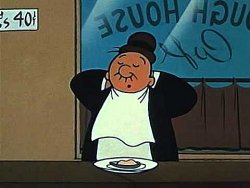
Paramount's Wimpy the Moocher |
 |
|
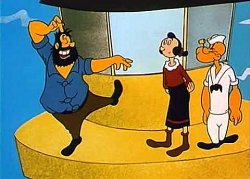
Jack Kinney's Lighthouse Keeping |
 |
|
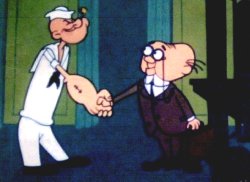
Gerald Ray's Where There's a Will |
Paramount Cartoon Studios: as good as anything they were doing theatrically at the time and
an admirable effort to film some of the Segar continuities - but several
notches below even what Famous Studios was doing during the 1950-55
period. The 1960-61 Paramounts
don’t move very quickly either. Overreliances
on stock animation (Popeye’s closing songs, the explosions) give them a
cookie cutter quality. The use
of Winston Sharples' music from the theatricals sometimes works, sometimes
doesn’t, especially when you can’t help associating a certain
composition with an earlier (theatrical) cartoon.
Still, they’re slick and moderately amusing.
The Kinneys:
As a group, the most uneven, and downright amateurish at time.
Ironically, these cartoons boast the best scripts and comic ideas
including Olive as a beatnik (Coffee
House), the Japanese-drama parody (Spinachonara),
the Alice in Wonderland takeoff (Sweapea
Thru the Looking Glass), but
on the whole pretty bad and hard to watch; badly timed and inexpertly
dubbed.
The Snyder/Rembrandt/Deitch: Best animation, though a bit on the hectic side
like the studio’s Tom and Jerrys. Very
good ideas such as the talking dog (Roger),
Olive becoming obese (Weight for Me),
the outer space juvenile delinquents (From
Way Out) and the like. The
Halas-Batchelor stuff is about the same.
The Gerald Ray
productions come closest to the spirit of the old Popeye with sharp
timing, funny throwaway gags and good lines.
Henry Lee knows the characters and writes well for them.
I liked Deezil Oyl (Olive’s niece) and would have liked to have
seen more of her.
FG: Do you feel
the series has been unfairly criticized as being entirely poor through the
years?
HE: Unfair yes.
Like any long-running series there are quite a few good ones but too many
clinkers. I think they’ve
gotten an overall bad rap because of the sheer volume of the Kinneys.
The group isn’t as evenly produced or consistently amusing as the
theatricals. When I was a kid
I was always happy to see the Rembrandts or the Gerald Rays.
The Paramounts, moderately happy.
The Harmons, ehh. The
Kinneys, groan (unless it turned out to be surprisingly good).
I can’t muster
up too much enthusiasm for these but the public at large accepted them and
they made a lot of money so it might be just a personal reaction. Also at
the time these came out I was really looking forward to them and
disappointed they weren’t better. This
may have clouded my judgment.
One thing in their
favor: They certainly aren’t chained to formula as some of the later
theatrical Popeyes. Maybe the multitude of studios resulted in more
variety!
|
Anything else you are dying to mention
and I have just forgotten to ask?
I
urge fans of this series to purchase the DVD Popeye the Sailor from the
Warner Archives. It features
all of the Paramount and Gerald Ray television produced cartoons.
If others are released perhaps some should come with the
subtitle, ”How Not to Make an Animated Cartoon!” Thanks for the
interview!
|